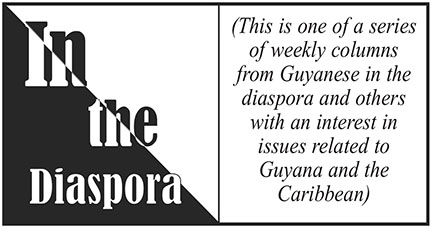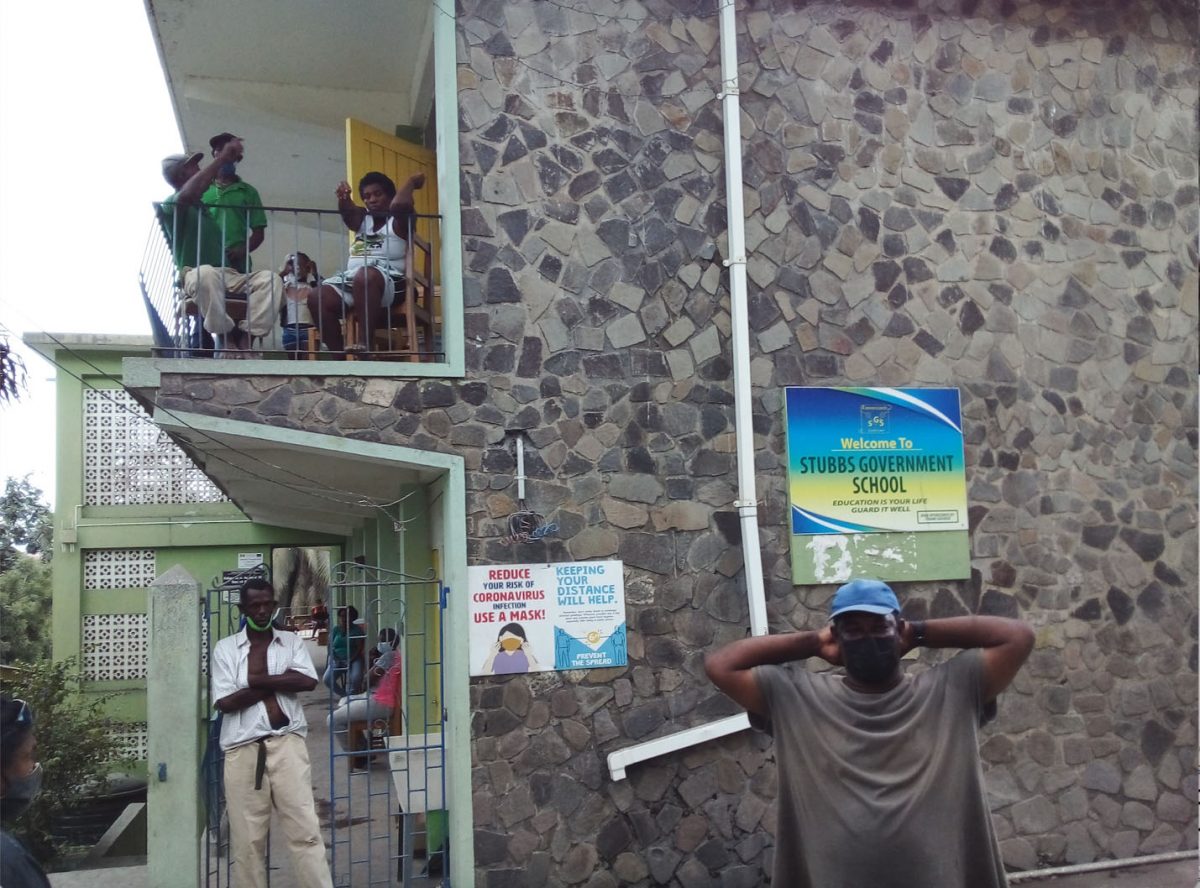 Judy Grant is a Vincentian born, PhD Candidate in Adult Education and Community Development at the Ontario Institute for Studies in Education (OISE) and the Collaborative Program in Women and Gender Studies at University of Toronto.
Judy Grant is a Vincentian born, PhD Candidate in Adult Education and Community Development at the Ontario Institute for Studies in Education (OISE) and the Collaborative Program in Women and Gender Studies at University of Toronto.
While sitting at my kitchen table to write this piece, tears roll down my face as I stare out of my window and catch a glimpse of the blue Atlantic Ocean through the brilliant sunshine dominating the grey volcanic ashes permeating Stubbs Village, in St. Vincent and the Grenadines.
On Friday April, 9, 2021 at approximately 08:41 a.m., the first of multiple major explosive eruptions blasted through the mountain, located on the northern windward side of the island. The dreadful and ongoing eruptions are wreaking havoc and catastrophic destruction upon the residents of St. Vincent and particularly the indigenous Carib/Garifuna peoples, many of whom were displaced from their now destroyed homes. Thousands of people had to be evacuated via land and sea from the so-called red zone to green zones further south. Most evacuees are now living in temporary shelters throughout the island.
The Stubbs Government School, located in Stubbs Village, where I grew up, is one of the designated shelters. I attended this primary school. I am now assisting the displaced residents at the Stubbs school shelter and another shelter which is within close proximity.
The Eruption
When the volcano exploded, I was on my veranda speaking to my neighbour. The entire village began to grow dark as thick ashes blanketed the village. The clouds were dark and grey, the ashes were everywhere, and it was difficult to see and to breathe. I looked towards the Stubbs Primary School and saw people standing and sitting outside. My uncle called out to confirm that the school was a designated relief shelter for evacuees. I immediately went into action mode. I messaged Marsha, the preschool teacher and a resident of Stubbs with deep roots and organising experience in the community. Marsha said, “Girl di thing real bad!” She told me that the people at the shelter did not even have some warm water to make some tea and that she was about to go to the grocery and buy them some food. I got dressed and walked to Marsha’s house and we went to a local shop then supermarket and bought groceries for the shelter residents. We bagged items and handed them out to as many people as possible. There were women and children (including toddlers) and men everywhere. The look of confusion, sadness, shock and uncertainty was clearly visible on people’s faces. It was heartbreaking to watch.
I walked around to assess the situation and speak to residents. The first room that I visited was occupied by a self-identified Carib woman and her teenage son lying on a cot. “Can you give me something for the pain please?” she asked me. “I had to sleep on these benches because they had no cots when we got here”, she explained. Her son is asthmatic and was not able to grab his puffer when they evacuated their homes. He looked sad and described having to leave his dog behind. This family includes a mother and her four children (two daughters and two sons) her three year old granddaughter, her mother (63 years old) and her cousin, an adult female and her husband. They are all from Owia and live in two houses – both were damaged in the eruption.
The situation was dire. There were several families at the shelter who had no food, water, cots to sleep, blankets or towels. The kitchen had no food and there appeared to be no preparation made prior to the evacuees being dropped off at Stubbs Government School, although it was a designated evacuation centre. We heard later that someone forgot to put the school on the assigned shelter list – although several ‘Shelter Management Team’ meetings occurred before the eruption started.
I got the woman some pain medication and continued to make my rounds.
People were sad, and some were saying that they did not get a proper night’s sleep, had no food and some were desperately trying to hold back tears as they recounted having to run away from their homes.
Community organizing at its best: The revolution is at the grassroots level and it is with the people
Since the volcano erupted, it illuminated where the strength, hope and possibility for transformational change truly is—the grassroots community! I was most amazed by the ways in which folks began to show up with food stuff, clothing and more. Women came with food stuff and began to cook for the shelter; folks began to drop off bottled water and canned goods; some could be heard uttering words of encouragement and others were praying. In the middle of all this, a Garifuna man, with his portable radio hanging on his chest, walks by blasting Bob Marley’s “Don’t worry about a thing” and smiles as our eyes met. The acts of kindness, generosity, love and care that community members were showing each other energized us. The displaced residents got into action, organizing makeshift home rooms, many smiling as they remind each other that God is in the midst and in control.
With the help of St. Matthias Charities Inc’s (STMCI) founder, Pastor Robert McBarnett, his wife Sharon and Esther (also a resident of Stubbs), I was able to organize some items which were at the charities’ headquarters: clothing, towels, toothpaste, toothbrushes, underwear, sanitary napkins, food stuff, bags and books etc. STMCI is a non-profit organization which was started in 2012 by Pastor McBarnett and his wife, my aunt Sharon Grant. It is a well established and committed charity that I am a part of, and whose efforts extend to other Caribbean islands including Grenada. I donate to STMCI and I promote and attend fundraisers in New York and volunteer here in St. Vincent.
STMCI made the decision to adopt Stubbs School shelter as its main site and to focus relief efforts on the residents there. By the end of day one, we had little water, food, clothing and sleeping cots (no sheets, pillows etc.) for displaced residents. It was terrible. We were unable to make contact with any representative from the National Emergency Management Organisation (NEMO).
The shelter manager and principal of the school organized his staff, and we sorted the items we had. We made a video asking for assistance on behalf of the STMCI and we distributed every item to those in need at the shelter.
Water Crisis
The water at the shelter was low and only one of the three water tanks was functioning properly. Water became a critical issue and there is still not enough drinking water at the site or in the village. The water catchment area was damaged, and it is still being repaired.
With the help of Mr. Rawleson Jerome Bullen, a project coordinator for a Grenadian based construction company, Kuwait Dynamics Constructions Ltd (KDL), we pumped water from local rivers to flush toilets and wash down ashes from and surrounding Stubbs School and St. Clair Deacon Secondary School, a second site housing approximately 105 residents, the majority of whom are Indigenous people. We are still experiencing the water crisis, but more people have been out with their personal trucks volunteering to deliver water to residents throughout the communities.
What I know is that transformational change is at the community level. What I see here in the days after the initial eruption is the multiple and varied ways by which communities love and care for each other throughout the most dreadful and uncertain times. This was evident from day one when I spoke to Marsha John and we met to organize the rapid response to providing the basic necessities to ensure that the most vulnerable amongst us were tended to with compassionate care and dignity. This is evident when Space man and other local business owners donated items to the shelter. We saw the kind of love that is rooted in communities of care when women cooked and delivered food to the empty kitchen and the pantry began to fill up, one can of tinned mackerel in tomato sauce aka ‘young tongue ‘(to use a Vincentian term) at a time. Time and again we saw how the women, in particular, showed up with clothes, water, food, sanitary napkins, toilet papers and deodorants and pampers for the babies in our shelter here at Stubbs, Yes, we do have a few little ones here with us and they are adorable.
There are approximately 22 children at the Stubbs Primary School and three toddlers. The echoing sounds of children’s laughter as they run up and down the stairs of Stubbs school drowns out the howling roars of La Soufriere as it competes for attention.
The vast majority of women at the Stubbs Government school and the St. Clair Deacon Secondary school shelters are Indigenous Carib/Garifuna, and they are here with their families. These women have been amazingly positive and have already started to organize activities such as entertainment and self-pampering (braiding and makeup). In the middle of all the chaos and uncertainty, a group of young women at the Stubbs shelter protested the lack of combs and requested hair braids, weaves, needle and thread, and makeup. “Not because we dey ah shelter that nah mean we do not want to look good and take care ah we self”, they explained. We laughed and agreed that a fashion show put on by the self-described “Hot Gyal Crew” will be a good event. They are currently planning this event. The men want to do their traditional dances and an 86 year old Carib woman, with her beautiful cane in hand, wants to tell us here stories about the 1979 eruption. We are planning story telling nights and dance offs too.
COVID -19
There has been no word on testing of residents within the shelter facilities here in Stubbs. There have been unofficial reports of several outbreaks at other shelters and so far there has been no clear information or directions on how we will be testing and/vaccinating people in the shelter population. There are vulnerable persons with underlying health conditions (diabetes, hypertension, asthma, the latter compounded by the effect of ashes on breathing). This is critical and the residents themselves are deeply concerned about the lack of testing.
Hope
The residents of the shelter are hopeful. Most of the displaced are from the Owia, Sandy Bay, Georgetown area. There are a few families from Fancy. Some families have received word about their homes. Many Indigenous women and their children are now displaced and some have lost everything. One woman broke down as she was fetching water to flush the toilets, recounting seeing a video of her modest home washed away by boiling river water. I hugged her tightly and she whispered in my ear “it nah easy to see everything ah worked so hard for gone.” But she was most disturbed by the lack of water to flush. She said she could handle the house mashing up; however, she could not handle getting a disease at a shelter because it is too nasty. I agreed and we both discussed the possibilities of rebuilding better and differently.
The Indigenous women and youth and children and men here are incredible. They are already walking through Stubbs, meeting and getting to know residents. Some have been to my home and the local businesses around. Others are readying themselves to have prayer meetings; I never knew I could preach but I have since found out. We are hopeful and we are full of hope.
The people are the revolution.






